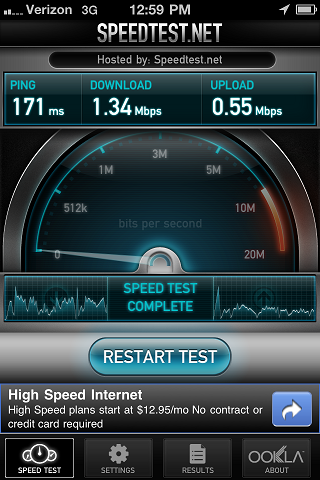

That's going to impact phone design and battery life negatively. 5G smartphones are going to be awful for the first year, as first-generation 5G modems and antennas take up a lot more space and power than our refined, well-worn 4G technology. Advertisementįurther Reading Don’t buy a 5G smartphone-at least, not for a whileThird big caveat: 5G hardware. His own tweet refers to the test as "historic," and we've got to guess the user base with 5G Verizon hardware active the very instant the 5G network went live was approaching "one person." With more people online, the network will be slower.

Second big caveat: there's a good chance Weissmann was the only person on Earth using Verizon's 5G network at the time of this speed test. 5G is all about building a network in the slice of spectrum we haven't used for other radio signals yet, and the reason this spectrum is available is because the performance characteristics are very challenging. 5G even has problems with the weather, so on a rainy or foggy day, performance will suffer. 5G's real problems come in range and penetration, so if you were indoors-or on the other side of a building, or if there was a tree in the way, or if you were farther away from the tower-performance would be significantly worse. Verizon's 5G equipment is actually visible in the frame of the video-it's all those boxes and antennas glommed onto the post lamp on the left. First, he is standing basically next to a 5G tower with a clear line of sight on a sunny day. Now for the list of many caveats with this video and with 5G in general. Weissmann's test-which was probably pre-approved by Verizon-is being run under ideal circumstances. According to testing by OpenSignal, 4G LTE latency is usually around 54-64ms, so while this is a bit of an improvement, it's not quite as fast as we were expecting. Verizon's Home 5G Internet supposedly has 4-8ms latency, while for mobile Verizon is only promising around 30ms (and showing 19ms in the speed test). The latency here isn't great compared to the previous promises of 5G.
#VERIZON FIOS WIFI SPEED TEST DOWNLOAD#
Weissmann's test is the closest we've come so far to seeing what real 5G performance is like, and today's press release from Verizon claims "early customers in Chicago and Minneapolis should expect typical download speeds of 450Mbps, with peak speeds of nearly 1Gbps, and latency less than 30 milliseconds." Advertisement Carriers are happy to crow about 5G rollouts and upcoming devices, but it has been rare to see actual numbers attached to 5G. Qualcomm's current 5G modem has a theoretically max speed of 5Gbps, but of course nothing is going to hit the theoretical maximum. Ookla's latest aggregate speed reports peg the average US mobile download speed at 27Mbps, while the average fixed broadband download in the United States is at 96Mbps. Unless you are rocking gigabit fiber Internet at home, this is probably much faster than your home Internet connection. Weissmann's speed test ended with a blazing-fast 762Mbps down and a 19ms ping (the video does not show upload speeds). Speed test here in front of US Bank Stadium Thrilled to be in Minneapolis as 5G UWB makes history!
#VERIZON FIOS WIFI SPEED TEST MOD#
Verizon spokesperson David Weissmann shared on Twitter the best look yet at 5G, where he showed a real-life 5G speed test, running on a real smartphone, getting data from a real 5G tower. Specifically Weissmann was out in Minneapolis, pulled out his Verizon™ Moto Z3 phone with the Moto 5G Mod attached, and loaded up the Ookla app.

Every carrier out there likes to slice and dice definitions to have the " First 5G" everything, but in terms of using a real, mmWave 5G signal and something approximating a 5G smartphone, Verizon has made the most progress yet in getting a 5G ecosystem up and running.ĥG is still in its very early stages, with access in only a few cities and almost zero device support, so it has been hard to know what 5G will really be like in the real world. It was a bit earlier than scheduled, but Verizon switched on parts of its 5G network today, debuting in "select areas" of Minneapolis and Chicago.


 0 kommentar(er)
0 kommentar(er)
